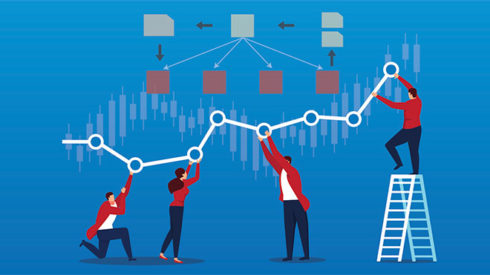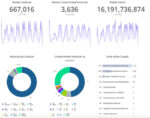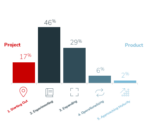
If 2020 taught businesses anything, it is that they need to be able to adapt at any moment if they want to stay competitive and be successful. But in order to do that, they need actionable insight into what is going on throughout the entire organization and how that is translating into business value.
Mik Kersten, CEO and founder Tasktop, says too often when a business takes on a new transformation or reorganization initiative, they end up cutting the wrong people, the wrong services, and making easily avoidable mistakes.
“Having a business visible representation of where the value is for the customer, and using that to guide both how you rebalance and how you invest into all of your activities is key,” he explained.
RELATED CONTENT:
A guide to value stream management solutions
What do you need to be successful at value stream management, and how can you help?
That visible representation is now known as value stream management (VSM). It maps people, process, technology and business value to eliminate waste and improve. It’s a new methodology that has rapidly been making a name for itself in the software development industry, and that businesses can no longer afford to put off, according to Bob Davis, chief marketing officer for Plutora.
“A year ago maybe the question was: is this a good idea? Is this something that I should prioritize? Now, people have to get that if they are going to be successful and competitive in software in their business, they are going to have to get good at software development. In order for them to get good at software development, they are going to have to transform. In order to transform, they are going to have to have visibility. In order to have visibility, they have to have value stream management,” he said.
Bryant Schuck, lead product manager for HCL Accelerate, a VSM platform, explained businesses might already be doing some form of VSM without even knowing it, but 2021 will be the year businesses start taking VSM seriously.
“A lot of companies are realizing, especially with how 2020 went, that we need to start looking at our processes,” said Schuck. “The end-to-end picture that VSM can provide is getting much wider. Companies are starting to realize there are bottlenecks outside of development, and are using value stream management beyond the scope of IT or software. It’s an end-to-end methodology that analyzes each facet of the business.”
Where VSM can help your business in 2021
COVID response. As the pandemic continues, organizations are going to need to constantly rebalance and reshift their IT portfolios and reduce or increase budgets to keep up with the changing economy, according to Tasktop’s Kersten. “Organizations realize that in each of those activities, whether they were actually investing more because the pandemic meant that some of their digital offerings were getting picked up more quickly than before, whether they were rebalancing to adjust with what was happening, or to help their staff whether this is from work from home, or whether they’ve actually cut it, they need a disciplined way, measured way to do it,” he said.
Improve Agile and DevOps initiatives. According to Gaurav Rewari, CTO and general manager of AI and VSM at Digital.ai, VSM is the next phase in the “logical evolution” of Agile and DevOps. It completes the vision of the methodologies, he explained. “Agile and DevOps are great, and they serve very, very important needs… but they’re not sufficient,” Rewari said. They serve very specific needs, which was to foster collaboration and be able to have self-organizing, cross-functional teams. But Agile and DevOps are missing the business outcomes and the value piece.
RELATED CONENT: A guide to value stream management solutions
Value stream management “really allows a mindset change because it’s about being able to prioritize your software investments based on the value being realized. Trying to track the flow of value across the different steps,” Rewari explained. “It goes from building a product, shipping it, and then having customers adopt it. It suddenly becomes the metric by which decisions are made, and it’s really about aligning the work of technology with the needs of the business.”
Better infrastructure. According to David Williams, vice president of product strategy at Quali, one of the benefits of DevOps is that it always encouraged teams to use whatever technology they needed in order to meet their delivery objectives. However, the problem with giving teams that freedom is that if it’s not maintained or managed properly, it can actually slow the whole process down. There needs to be a way to capture any changes being made so tools and technology don’t bog down the process.
“I can’t let 700 teams go out there and just use everything they want and not be accountable to the bottom line. You have to have some controls that have been put in place,” said Williams. “Think about it as you are constantly building Legos. You’re adding more Legos, and you’re only using a subset, but the Legos from the previous build are still there.” What that does, Williams explained, is it causes things to slow down and it takes up infrastructure usage. It needs to be removed so there aren’t any unnecessary pieces in the infrastructure that you weren’t aware of or forgot about.
Treating infrastructure as a valuable piece of the life cycle can help businesses optimize spend while managing change and enabling everyone to do their job. “You want to make sure that as things move through the life cycle of an infrastructure, that when you plan it, when the developers develop it, when the testers test it, the release people release it, whatever the practice is, it’s being maintained and managed in context,” said Williams.
The adoption of BizOps. In order to help businesses express and implement their goals as well as connect to the development side of things, the BizOps Manifesto was released at the end of 2020. It’s a framework that addresses the needs of the business and IT, and helps enterprises work towards common outcomes. Some of the guiding principles include: Business outcomes are the primary measure of success; and business leaders need to make informed technology investment decisions that drive business growth, improve customer experience and increase profitability.
According to Tasktop’s Kersten, this idea of BizOps will be closely tied to VSM in 2021.
“Fundamentally, what knowledge management is about is making the key metrics, the value streams themselves, visible to the business. BizOps is a way of expressing that,” he said. Those goals of BizOps cannot be possible without value stream management. “It’s not enough to do Agile and DevOps to do BizOps, you have to be applying the principles and implementing the infrastructure, tooling and visibility that value management provides,” Kersten added.
What can you expect to come out of the VSM space in 2021?
More education and training. Now that organizations are aware of VSM and all the benefits it can bring, it’s time to fill in some of the missing pieces — mainly education and training, according to Lance Knight, COO for the value stream integration platform ConnectALL.
“Everyone is saying ‘I’ve got a tool. I’ve got the tool,’ but nobody says I’ve got the tool services to help you be effective at it,” Knight explained. “We are still trying to figure out what VSM is and how to do it.”
Knight looks at 2020 as the year of awareness for value stream management. And now that everyone is realizing they should be doing this, it’s time to think about how to effectively do it.
He explained that there is no “VSM for Dummies” book yet, or really any ways to get certified in this area. As more vendors come out releasing new VSM capabilities, businesses need to be educated on what they want to achieve, and how the tool will help them.
“You need someone who is going to educate and help you understand it, without charging a large fee,” said Knight. “Value stream management is human….we need to help engineers. The humans need to understand the methods and the processes to remove waste. We all have to understand that we have to train and educate and formalize what it means to be a value stream management expert.”
It’s like having a great car in the driveway, but if you don’t have a driver’s license what’s the point? Knight explained. “That’s where I see value stream management going… to people getting their VSM driver’s license.”
More AI being applied to the space. According to Gartner, predictive analytics are going to be a key capability being offered in value stream management tools as “organizations are increasingly embracing the value of analytics to ensure successful deployments and demonstrate reduced production defects.”
Digital.ai is already dedicated to giving its users more AI capabilities in 2021. The company just announced four new patents: automated health assessment and outage prediction; warehouse-based reporting and operational reporting integration; input gathering system and method for defining, refining or validated star schema for a source database; and model-driven reporting.
“Given today’s volatility, many enterprises have either slowed down or paused updates to their applications. However, their customers are relying on them to innovate more now than ever before. The capabilities represented by these patents enable IT organizations to continue to rapidly drive value for their customers while mitigating risk to the business,” said Rewari.
Plutora’s Davis also sees a trend towards predictive analytics. “The good news is you now have all this information. The bad news is, you now have all this information. How do you take that information and make meaningful insights out of it?” asked Davis. He sees more of a move toward capabilities that help users understand their data better and make smarter decisions.
Standardization. As more vendors try to come into the space, there needs to be a way to standardize or formalize the capabilities so people don’t get confused, according to Davis. “We have to standardize… integrations can’t be the differentiator,” he said. Everyone should have integrations because they are so critical to connecting the tools and gaining the awareness of what’s going on. “There is going to be a lot of need to better standardize, better understand the differences between simple field mapping and complicated logic in terms of how these tools are being used,” he said.
VSM 2.0. We are still in the early stages or 1.0 phase of value stream management, but HCL’s Schuck sees VSM 2.0 on the horizon. “We are close to crossing the line of value stream management being a nice to have or cool new thing to VSM becoming an essential in your toolbox,” he explained. “VSM 2.0 comes with customer success, customer use cases, and VSM coaches. Right now, we’re in the thought leadership stage with lots of DevOps experts talking about the benefits of VSM and practitioners testing the VSM waters. We’ll see more people diving into value stream management once big companies have well-established VSM programs, broadcast their results from these programs, and start hiring VSM coaches or other VSM-specific roles.”
Value stream management platforms vs. value stream delivery platforms
Research firm Gartner splits the value stream management tooling landscape into two areas: value stream management platforms and value stream delivery platforms.
According to the research firm, “DevOps value stream management platforms (VSMPs) enable organizations to optimize end-to-end product delivery lead time. These platforms provide greater visibility and traceability into the flow of all product delivery processes, from ideation to release and operation.”
While, “DevOps value stream delivery platforms (VSDPs) provide a fully integrated set of capabilities to enable continuous delivery of software. These capabilities may include project or product planning, build automation, continuous integration, test automation, continuous deployment and rollback, release orchestration, and automated security policy enforcement, and may provide visibility to key value stream metrics.”.
Gartner believes VSMPs should be used:
- To get end-to-end visibility and insight into product delivery
- Assess the performance, quality and value of products
- Evaluate the maturity of existing product delivery capabilities
- Identify constraints to flow and gaps in insights
- To get customized dashboards and view product delivery
- For a consolidated view of governance, security and compliance
- And for advanced capabilities such as risk analytics
Don’t use a VSMP: until you have proper experience and success with DevOps software delivery, and when you need a platform for the entire organization and its many stakeholders, according to Gartner.
Gartner believes VSDPs should be used when:
- The benefit of a fully integrated platform outweighs the cost and effort to manage a complex toolchain
- Specialized VSDP capabilities in one area of the application delivery value stream are essential
- The licensing and pricing advantages of VSDPs make it more attractive than stitching together a complex DevOps toolchain through multiple vendor relationships.
Users should not use DevOps VSDPs when choice dictates app architecture; VSDPs don’t integrate with essential tools to support missing gaps; and if product teams aren’t ready to replace existing tools, according to Gartner.







